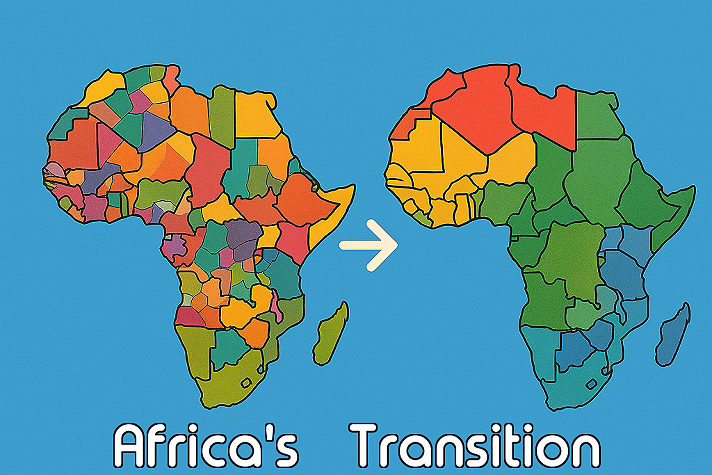"My Vision For Africa Moving Forward"
Reorganizing Africa for maximum potential involves moving away from the "carved up" borders of the colonial era and toward a model of continental integration and regional sovereignty.
Based on current major strategic frameworks (like the African Union's Agenda 2063) and economic theories, the "best" reorganization isn't about redrawing borders on a map, but erasing their economic and political friction.
Here is a blueprint for how that reorganization is currently envisioned to maximize tech, growth, and empowerment.
1. Political Reorganization: From Nation-States to Regional Blocs
The colonial borders (viewed in your previous search) often split ethnic groups and resources illogically. The modern solution is supranational integration—essentially acting as large regional blocs rather than 54 fragmented small markets.
Strengthen Regional Economic Communities (RECs): Instead of one giant leap to a single government, power is best devolved to major blocs like the EAC (East African Community) or ECOWAS (West Africa). These blocs can harmonize laws, currency, and travel, similar to the EU model.
The African Union (AU) as a Federal Authority: The AU requires more enforcement power to handle continental defense, foreign policy, and major infrastructure, allowing individual states to focus on local governance.
Dissolving Borders for People: Implementing a continent-wide [suspicious link removed] to allow free movement of labor. This allows talent (engineers, doctors) to move where they are needed most without visa restrictions.
2. Economic Reorganization: The Single Market Strategy
The most significant current reorganization is the African Continental Free Trade Area (AfCFTA). To maximize growth, this must be pushed further to create a unified economic engine.
Internal Trade First: Currently, African countries trade more with Europe or China than with each other. Reorganizing supply chains to source materials internally (e.g., Ghana selling cocoa to a chocolate factory in South Africa rather than Switzerland) retains wealth on the continent.
Green Industrialization: Rather than just exporting raw minerals (lithium, cobalt), Africa can reorganize as a manufacturing hub for the green economy.1 For example, Ethiopia's eco-industrial parks and Morocco's solar complexes show how states can specialize in high-value, sustainable exports.
Common Currency Zones: Reducing reliance on the US Dollar or Euro for intra-African trade by utilizing regional currencies or a pan-African digital currency settlement system (like the Pan-African Payment and Settlement System - PAPSS).
3. Technological Reorganization: The "Digital Leapfrog"
Africa has the unique advantage of not having to replace aging 20th-century infrastructure; it can skip directly to the latest tech.
Digital Sovereignty: Africa currently relies heavily on foreign infrastructure (like China's Digital Silk Road).2 Reorganization requires building African-owned data centers and fiber networks to keep data and digital revenue within the continent.
Pan-African Digital ID: Creating a unified digital identity system (interoperable across borders) would allow a farmer in rural Kenya to bank, trade, and sign contracts with a firm in Nigeria instantly.
Tech Hub "Special Economic Zones": Designating specific cities (e.g., Lagos, Nairobi, Kigali, Cape Town) as tax-free tech zones to attract venture capital and startups, fostering clusters of innovation that serve the whole continent.
4. Social & Educational Empowerment
Reorganizing society to empower the youth demographic (which will be the world's largest workforce by 2035).
Standardized STEM Curriculum: Harmonizing education standards across the continent so that a degree from a university in Senegal is recognized instantly in Kenya. Focus heavily on coding, AI, and green tech.
Unified Health Procurement: As seen with Egypt's proposal for a unified health platform, purchasing medicine as a bloc (1.3 billion people) lowers costs and ensures access to advanced medical tech.
Empowerment through Connectivity: Universal broadband access (via satellite or fiber) is viewed as a human right, essential for rural education and telemedicine (like Rwanda's Zipline drone delivery network).
Summary Comparison: Old vs. New Organization
Feature | Colonial / Old Model | Proposed "Reorganized" Model |
Borders | Rigid, drawn by outsiders | Porous, open for trade & travel (AfCFTA) |
Economy | Resource extraction for export | Value-added manufacturing & internal trade |
Infrastructure | Roads/Rails lead to the ocean (for export) | Roads/Rails connect countries (Trans-African Highways) |
Tech | Consumer of foreign tech | Creator of local solutions (Fintech, AgriTech) |
Governance | Fragile Nation-States | Strong Regional Blocs (RECs) + African Union |
Current Momentum:
Many of these steps are already in motion with projects like the Great Green Wall and Smart Africa Alliance are pushing the environmental and digital reorganization forward.
























